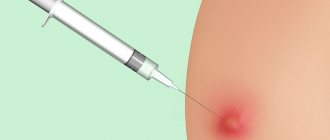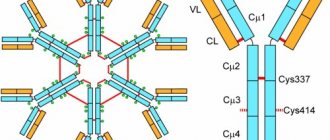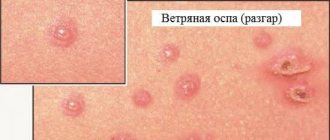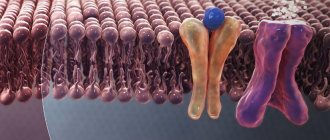→
Information
→
Vaccinal prevention
We work seven days a week and holidays
COVID 19: antibody tests
Most vaccines cause local adverse reactions after vaccination, almost all of them are not dangerous to health and disappear within a few days. The most typical reactions: redness, thickening, pain at the injection site. Many vaccines, including those against coronavirus, are administered into the arm, so many people complain of pain in the arm after vaccination.
Soreness at the injection site is a typical reaction to a somewhat rough intervention, from the body’s point of view: a violation of the skin, foreign substances under the skin and in the muscles, often in large quantities. We should not forget about the possible reaction of a particular organism to individual components of vaccines.
Sometimes, of course, pain and even bruises after an injection are the consequences of inept or even negligent actions of medical personnel: the needle got into soft tissue, a nerve or large vessel was accidentally hit, they were pricked with a dull or old needle, the wrong needle was used, improper storage of the vaccine (this is especially true Some COVID-19 vaccines that require fairly cold temperatures) have not been tested or the individual's contraindications have not been met.
In most cases, the pain goes away within 1-3 days, but sometimes it can linger for a week. A longer period or severe pain is a reason to consult a doctor.
Before you get vaccinated
Taking into account the fact that in the vast majority of cases, vaccinations are well tolerated by healthy children without any preparation or pre-treatment, the most important point in preparing a child for vaccination is to determine contraindications to vaccinations, that is, those cases of illness in a child in which vaccination can give serious adverse reactions. Contraindications and precautions for vaccination; in some cases, vaccination in children is either strictly prohibited or should be postponed to a later date. In order to correctly assess contraindications and precautions for vaccination in a child, it is important to follow the vaccination calendar and know in advance which vaccination should be given to the child and when. Before vaccinating your child and on the day of vaccination, read what contraindications and precautions are associated with the administration of a particular vaccination and make sure that the child does not have any contraindications for the vaccination. If you find it difficult to determine certain contraindications or precautions (for example, how dangerous a child’s cold or cough is), show it to your doctor. You should not blindly refuse vaccination because of a slight runny nose or cough - this will only disrupt the vaccination plan.
Tetanus symptoms
The first symptoms of tetanus appear several days or weeks after contracting tetanus. The average incubation period is seven to eight days. Typically, tetanus bacteria enter the body through a break in the skin.
The most common symptoms of tetanus are the following (in order of appearance):
- Cramps and tension in the jaw muscles
- Neck muscle tension
- Difficulty swallowing
- Abdominal muscle tension
Painful generalized (affecting all muscles of the body) tonic convulsions, which are provoked by a loud sound, bright light, touching the patient, etc. Such convulsions are called opisthotonus.
In addition to these main symptoms, general infectious symptoms of tetanus may occur:
- Fever;
- Increased sweating;
- High blood pressure;
- Heartbeat.
Treatment of fever and prevention of allergies after vaccination
An increase in temperature is a normal reaction of the child’s body to a vaccination, which means that the immune system has responded to the vaccine and is beginning to develop immunity (however, the absence of an increased temperature after vaccination does not mean that the vaccination was ineffective). In the case of completely healthy children, the temperature should not be lowered after vaccination if it does not exceed 38.5C. In cases of a more significant increase in temperature, and also when the temperature remains at 38.5 C in the evening, the child should be given an antipyretic. To treat fever after vaccination, it is recommended to use Paracetamol. Aspirin should never be used as an antipyretic in children.
In the case of children with a tendency to febrile convulsions, treatment should be started when the temperature rises above 37.5 or the child should be given an antipyretic before the temperature appears, if so advised by the neurologist observing the child.
Prevention of allergic reactions after vaccinations is indicated only in the case of children prone to developing allergies. In such cases, it is recommended to use Suprastin or another antihistamine as prescribed by a doctor.
What is tetanus?
Tetanus (tetanus) is a severe infectious disease with wound transmission, manifested by damage to the motor structures of the nervous system with the subsequent development of muscle contraction uncontrollable by a person in the form of constant tonic tension and periodic clonic convulsions. Due to the severity of this infectious pathology and high mortality rate, even with modern medical capabilities, most countries carry out specific vaccination, which is included in the compulsory vaccination calendar. However, the incidence, especially in countries with poor sanitary standards and lack of vaccination, remains quite high.
Treatment of redness and swelling at the injection site
Most vaccinations result in more or less severe redness or swelling at the injection site. The most severe local reaction to vaccination is observed in the case of DTP (redness, swelling and pain at the injection site) and BCG (formation of a long-lasting non-healing ulcer). For all types of vaccinations, it is recommended to avoid any local treatment for redness or swelling at the injection site. If the child scratches the injection site, it can be covered with a light gauze bandage. At the site of the DTP, a compaction often forms, located deep in the muscle - a “bump”. Often such a lump is painful, and the child easily limps on one leg (if the vaccine was injected into the thigh). The formation of a dense “bump” after DPT is considered a normal reaction and does not require any treatment. Within a few weeks, the lump will resolve on its own.
What vaccines can cause arm pain?
| Vaccination / vaccines | Local reactions |
| Prevention of COVID-19 Gam-Covid-Vac (trademark “Sputnik V”), EpiVacCorona, CoviVac | Pain, redness and thickening in the first 3 days. Read more in a separate article. |
| Prevention of whooping cough, hepatitis B, tetanus, polio ADS, ADS-M, DPT, Pentaxim, Poliorix, Regevak, Tetraxim, Engerix B | In the first 3 days – pain and redness at the injection site |
| Prevention of hepatitis A Avaxim, Havrix | Pain, swelling and redness may occur in the first 3 days |
| Flu prevention Vaxigrip, Influvac | In the first 3 days – pain, redness and slight swelling at the injection site |
| Prevention of tick-borne encephalitis FSME-IMMUN Junior, Ecevir | Pain, tenderness and redness at the injection site for the first 3 days |
| Prevention of meningococcal and pneumococcal infections ACT-HIB, Meningo A+S, Prevenar, Hiberix | Pain, swelling and redness may occur during the first 3 days. |
| HPV prevention Gardasil | Pain, swelling and redness may occur for 5 days |
| Prevention of rabies Cocav | Swelling, redness, itching, soreness |
| Prevention of yellow fever | In the first 3 days – pain and redness at the injection site |
| Prevention of typhoid fever Vianvac | Pain, thickening and redness in the first 3 days |
Frequently asked questions about the disease
How to treat tetanus?
The basis of treatment is the immediate administration of tetanus toxoid serum or antitoxin to the patient, which removes the consequences of the toxic effects of pathogenic microflora. At the same time, anticonvulsant therapy and elimination of the consequences of damage to the peripheral nervous system are carried out, as well as stabilization of cardiac activity. All of the above manipulations are carried out in an intensive care unit.
Why is tetanus dangerous?
Hiding in the body and continuing to actively reproduce, the anaerobic bacillus Clostridium tetani may one day make itself felt with a convulsive syndrome, rapid heartbeat, and a sharp deterioration in condition. The listed symptoms will increase, aggravating the pathological condition of the patient. In the absence of immediate qualified treatment, the risk of death approaches 100%.
How long does it take for tetanus to appear?
The first unpleasant symptoms in the form of muscle numbness and cramps may appear several days, weeks or even a couple of months after the infection of the body. It all depends on the functioning of the immune system and the amount of infection that has entered the body. With timely vaccination, the disease can be asymptomatic or make itself felt with rare mild convulsions.
Complications of tetanus
Severe complications of tetanus with a high probability of death are asphyxia and cardiac arrest. In addition, tetanus can contribute to the occurrence of bone fractures, muscle ruptures, and compression deformation of the spinal column. A common complication of tetanus is pneumonia, and coronary spasm and myocardial infarction may develop.
During recovery, contractures and paralysis of the third, sixth and seventh pairs of cranial nerves are sometimes noted. In newborns, tetanus can be complicated by sepsis.
Treatment of tetanus
Therapy is carried out only in a medical hospital, regardless of the form and severity of tetanus. In severe cases, treatment is carried out in an intensive care unit. Therapeutic measures for tetanus are complex and include:
- Introduction into the body of a specific immune antidote that inactivates tetanospasmin and other exotoxins of the tetanus bacterium - for this, horse immune serum or human anti-tetanus immunoglobulin is used. These biological products contain antibodies that bind and neutralize toxins in the patient's body.
- The use of muscle relaxants (myorelaxonium, ditilen), they relieve an attack of titanic convulsions for a period of 15-20 minutes.
- Intravenous administration of special buffer solutions to reduce the severity of metabolic acidosis (sodium bicarbonate solution). To prevent respiratory arrest, tracheal intubation is performed and the patient is transferred to artificial pulmonary ventilation (ALV).
- Centrally acting sedatives (phenobarbital, seduxen), which help reduce the severity of impulses in motor neurocytes of the central nervous system.
- The use of cardiac glycosides to normalize pumping function and heart rhythm.
- Antibiotics to prevent the development of secondary bacterial infections.
The patient is discharged from the hospital only after complete normalization of his general condition and the absence of re-development of cramps and tension of the striated muscles.
Etiology and causes
The anaerobic gram-positive bacillus Clostridium tetani comes from birds, humans and herbivores. The pathogenic microorganism is located in the intestines of the carrier and enters the environment along with the feces of the diseased organism. It can enter the body of a healthy person through damaged skin or mucous membrane. Often these are wounds, abrasions, punctures, crushing from impacts, falls, etc. There is a high risk of infection if antiseptic rules are not followed when treating frostbitten or burned areas of the patient’s skin.
If, after entering the body, the pathogen finds suitable living conditions for itself, it begins to actively reproduce in a vegetative manner. The anaerobic space inside deep purulent wounds, punctures, etc., where there is no access to fresh air, is considered the most favorable for the incubation period of tetanus. During the process of life and reproduction, the rod secretes potent toxins tenatospasmin and tetanolysin. They have a negative effect on the nervous system and blood composition, complicate the work of the heart muscle and contribute to the destruction of tissue in the affected area. Under the influence of toxins, the peripheral nervous system produces characteristic tonic convulsions, which are often used to determine the fact of infection. The first symptoms of the disease may appear 1-2 months after infection, which depends on the number of pathogenic microorganisms that entered the body through a wound or damaged skin.
Vaccination schedule
For routine immunization of children and adults, a combined DTP vaccine is used, which contains tetanus, diphtheria and whooping cough toxoids. Tetanus vaccination is included in the national immunization schedule, and the vaccination schedule differs between children and adults.
Vaccination of children
How many tetanus vaccinations are given to children? In total, the child is given 5 doses of the DTP vaccine; after completing the course of immunization, the child develops a stable immunity that lasts for 10 years. Children are vaccinated in the following age periods:
- At three months of age;
- At 4.5 months;
- In six months;
- At one and a half years;
- At 6–7 years old.
To maintain immunity, revaccination is necessary every 10 years. The first revaccination is carried out in adolescents at 14 or 16 years of age.
Vaccination of adults
Tetanus vaccination for adults is carried out in accordance with the order of the Ministry of Health of the Russian Federation No. 174 of May 17, 1999. Tetanus vaccine schedule for adults:
- 18 – 27 years old;
- 28 – 37 years old;
- 48 – 57 years old;
- After 58 every 10 years.
If an adult has been vaccinated against tetanus before, then every decade a revaccination is carried out with one dose of tetanus toxoid. In case of no previous immunization against infection, 2 doses of tetanus toxoid are administered, keeping a month's interval between their administrations.
When to see a doctor
If a child or adult experiences convulsions after vaccination, it is necessary to take him to the hospital.
Serious complications occur rarely - less than 1%. However, there is a risk, and you need to be able to recognize dangerous conditions in time:
- The reaction to the vaccine lasts more than two days.
- The pain under the shoulder blade is jerking, shooting in nature and intensifies.
- The area of redness increases.
- Vomiting more than once.
- The headache is difficult to relieve with painkillers.
- Convulsions appeared.
- Hives all over the body.
- A drop in blood pressure immediately after vaccination or on the first day.
- Difficulty breathing.
- The pain radiates to the arm or the other half of the back.
There should not be such signs even with a very severe reaction to the vaccine. If they occur, the patient should immediately consult a doctor. With timely assistance, these conditions pass without leaving serious consequences. If they were observed, in the future this will become a contraindication for repeated vaccinations with the same drug.
Signs of tetanus
Signs of tetanus that you should pay attention to and go to the hospital immediately include:
- facial muscle spasms;
- "sardonic smile";
- spasms of the muscles of the back and abdomen;
- labored breathing;
- temperature increase;
- increased excitability and insomnia;
- increased sweating;
- asphyxia and apnea;
- impaired renal and urethral function;
- cramps with pain throughout the body.
Tonic and clonic convulsions replace each other and cause severe pain in the patient. The slightest creaking or other loud sound, jolts and even touches cause irritation in the patient and, as a result, another attack of convulsions. Due to severe spasms and contractions of the muscles of the limbs, bone fractures, damage to the diaphragm and respiratory muscles can occur, which causes asphyxia and death from suffocation. Congestion due to poor circulation can affect the subsequent development of pneumonia.
Body temperature directly depends on the strength of convulsive attacks; with frequent and severe convulsions, it can rise to 42ºC. The heart rate increases to 120 beats per minute. Heart sounds are distinct and loud. When blood pressure drops, the prognosis can no longer be reassuring. The removal of waste products becomes more difficult against the background of spasms of the perineal muscles.
Despite the worsening symptoms of tetanus, the person remains conscious and clearly understands the situation throughout the entire course of the disease. No specific changes in internal organs are observed
Diagnosis of tetanus
With tetanus, laboratory diagnostics are practically meaningless, since at the onset of the disease the toxin is not detected in the blood, antibody titers do not increase (even a lethal dose of the toxin is an insignificant antigenic irritant and does not cause an immune response). The detection of antitoxic antibodies can only indicate a history of vaccinations. Sometimes bacteriological methods are used (histological examination of tissues obtained during surgical treatment of wounds, microscopy of fingerprint smears, inoculation of wound discharge under anaerobic conditions in nutrient media).
However, early diagnosis of this disease is possible only with a careful collection of epidemiological history (injuries, burns, wound infections, surgical interventions received within a time frame that corresponds to the incubation period) and with the active detection of symptoms of the prodromal period. At the height of the disease, there are no problems with diagnosis due to the presence of pathognomonic symptoms. At the same time, there are no deviations from the internal organs, meninges, cerebrospinal fluid, blood and urine.
In some cases, wound examinations are carried out using a bacteriological method:
- histological examination;
- smear microscopy;
- inoculating samples from the wound under conditions similar to the human body.
Based on the signs of the disease during the clinical course of the disease, the diagnosis is made without difficulty or doubt. Despite the fact that the symptoms may be similar to diseases such as rabies, strychnine poisoning and hypofunction of the thyroid glands, lockjaw and a painful smile are unique to tetanus.
Meningitis and meningoencephalitis, traumatic brain injuries, hysterical and epileptic seizures, exacerbations of osteochondrosis also require study when diagnosing tetanus.
Causes of sunworm infection
Tetanus is caused by Clostridium tetani spores entering a wound. In the absence of oxygen, they transform into active forms. The bacterium itself is harmless. But it produces the strongest biological poison - tetanus toxin, which is second only to botulinum toxin in its toxic effect.
Routes of infection with tetanus:
- puncture, cut or laceration wounds;
- splinters, skin abrasions;
- burns/frostbite;
- fractures and animal bites;
- umbilical wound in newborns.
People who need frequent injections are also at greater risk. Any wound (including bites and burns) increases the risk of contracting tetanus.
The most common causes of death from tetanus are:
- choking as a result of prolonged spasm of the vocal cords or respiratory muscles;
- heart failure;
- spine fracture;
- pain shock.
- In children, tetanus is complicated by pneumonia, and at a later date by indigestion and anemia.







